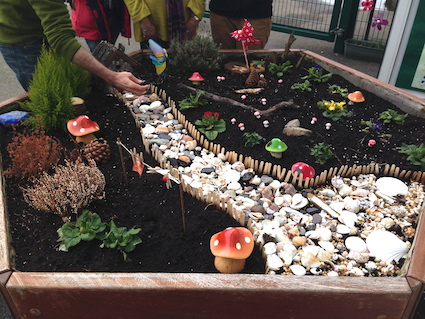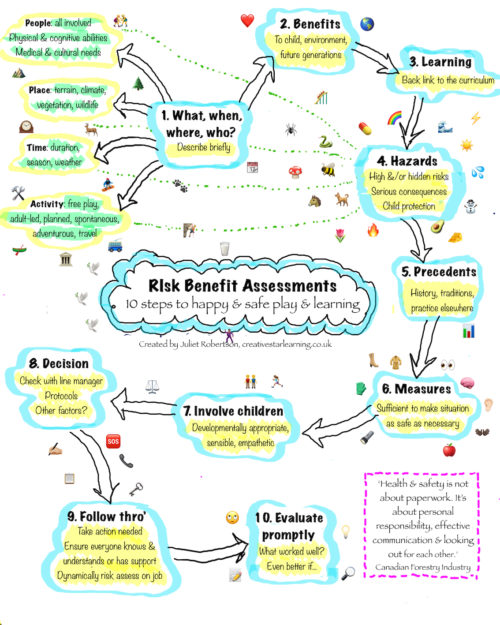
With the rise in popularity of schools and nurseries providing fairy gardens for these magical creatures to inhabit, I thought it was appropriate to consider what you may need to put in your risk benefit assessments relating to their care and wellbeing. Admittedly, I am concerned that we are not giving more thought to their needs, especially given a cultural long-term focus on “elfin safety” which seems to omit other commonly invisible species.
I thought it would be best to do this using the approach advocated within the play sector. For quick links to various forms and worked examples, have a look at Tim Gill’s blog post on his Rethinking Childhood website. Please copy, amend and adapt the suggestions below into your own formats, using common sense. It’s important you do this, as it would appear that fairies have significant cultural differences depending upon their location within the UK and beyond.
Benefits
- Children learn about fairy culture, laws, their needs and habitats. Caring for fairies and creating fairy gardens helps develop empathy and compassion for other species.
- Fairies are kind problem-solvers. They have a long history of helping humans who are experiencing difficulties of various sorts.
- Biodiversity matters so we need to look after fairies and other commonly invisible creatures – they bring beauty and value into the world.
- A fairy’s spirit comes from natural features and objects such as flowers, berries, insects and other animals. By looking after these, we can help look after our resident fairy population and support their needs.
- Fairies have special powers which are largely used for the greater good.
- Fairies occasionally leave good luck charms for humans to find.
- Certain species of fairy, specifically tooth fairies, provide young children with money in exchange for a baby tooth.
- Fairies try to source their wands locally from natural materials such as feathers.
- Fairies are positive role models for going barefoot.
- Sometimes a fairy will help make a human wish come true.
Risks
- Fairies use bluebells to call other fairies to a meeting or gathering. The sound of a bluebell is fatal to humans. Consider planting only silent species that both children and adults cannot hear.
- Performing spells and enchantments. Fairies are prone to making mistakes, particularly when learning their art. However, when this happens, they do their best to make amends or usually another fairy steps in to rectify any damage caused.
- Please see local factors, precedents and comparisons below in addition to the list above.
Local factors
Local, cultural differences have been recorded in different parts of the UK, Neverland and world-wide. Please amend your forms accordingly. Be aware of things such as:
- Fairies taking different animal guises, e.g. the form of a deer – more common in Scotland with fairy women.
- Different behavioural traits – occasionally some types of fairies are malicious or choose to play tricks on humans.
- Variations in size – From child-size to ones that a child could hold on the palm of their hand.
- Variations in dress – reports of fairies in suited armour to being dressed to camouflage with different species of flowers.
- Fairy godmothers – generally these are positive appointments and foster good relations between human and fairy populations.
Precedents and/or comparisons
Significant documentation about fairies exists. An online research and consultation with local folklore experts should provide you with the information you need within your community and neighbourhood. Be aware of any child abductions by fairies and the likelihood of a changeling being substituted – more of a risk with very young babies. However, check the number of instances this has happened, as most seem to be historically isolated cases and have happened in the home rather than at an educational establishment.
Decision
The benefits of fairy gardens and increasing local fairy populations through habitat improvements would appear to far outweigh the risks – though serious, by all accounts are extremely rare. Thus it is reasonable for schools and nurseries to develop fairy gardens of different sizes and types.
Actions taken
See comment about bluebells, which is a seasonal risk. Plant only types which cannot be heard by humans. If in doubt, consult a horticultural or wildlife expert.
Ongoing management and monitoring
Consult and involve children in the maintenance and management of the fairy garden. Help them to research and consider the needs of fairies such as useful plants to grow and for what purposes, such as:
- Provision of feathers, flowers and other plants for wand making
- Small bushes and places for spiders to live. The dew-laden spun webs are used by fairies as table cloths when holding midnight tea parties.
- A range of small stones where fairies can safely leave their imprints and store spare spirit and magic.
- A gathering space for fairies to meet. Toadstool rings are not always necessary for this purpose.
I hope this is helpful and would welcome any further ideas and input so that we can all provide better habitats for fairies and other magical creatures. I’ve blogged previously about fairies here, here and here.
PS If you hadn’t realised, this was posted on the morning of April 1st and is an April Fool’s post 🙂 Gotcha! However the general approach to thinking through the benefits as well as the risks is serious 🙂 Below is a sketch note which may also be of use. Please get in touch if you would like a full-size pdf (the resolution is too high to put on my website).





















It’s elfin safety gone sane!
Thank you Tim. Agreed. Perhaps the RBA was the magic wand the HSE were needing 🙂